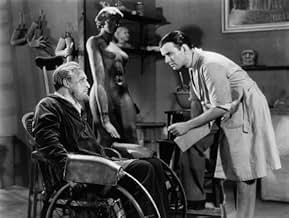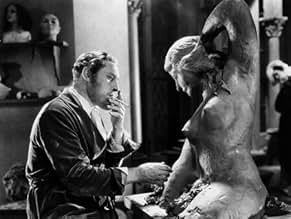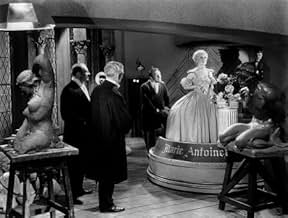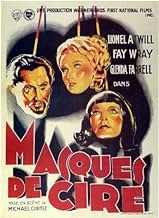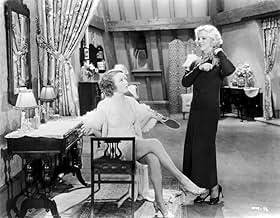AVALIAÇÃO DA IMDb
6,8/10
7,2 mil
SUA AVALIAÇÃO
Em Londres Ivan Igor, um escultor de figuras em cera, luta em vão para impedir que Joe Worth, seu sócio, ponha fogo no museu para receber o dinheiro do seguro.Em Londres Ivan Igor, um escultor de figuras em cera, luta em vão para impedir que Joe Worth, seu sócio, ponha fogo no museu para receber o dinheiro do seguro.Em Londres Ivan Igor, um escultor de figuras em cera, luta em vão para impedir que Joe Worth, seu sócio, ponha fogo no museu para receber o dinheiro do seguro.
- Direção
- Roteiristas
- Artistas
Thomas E. Jackson
- Detective
- (as Thomas Jackson)
Bull Anderson
- Janitor
- (não creditado)
Frank Austin
- Winton's Valet
- (não creditado)
Max Barwyn
- Museum Visitor
- (não creditado)
Wade Boteler
- Ambrose
- (não creditado)
- Direção
- Roteiristas
- Elenco e equipe completos
- Produção, bilheteria e muito mais no IMDbPro
Avaliações em destaque
She has been so sorely maligned. Despite what has been claimed by others here, Glenda Farrell was not a bad actress. A little broad sometimes perhaps, but not bad. She is a dynamo of live energy, which the film badly needs, for the only other energetic character in the film is Atwill, and only Farrell has the force to bring him down(that the script does not let her do so personally betrays the character). It is not Farrell's performance or even her character which is the problem of the film, but the script which makes that character necessary. Chock Full O' undeveloped characters (only Atwill and Farrell qualify as more than ciphers)whose paths cross coincidentally,Farrell's reporter is the one in the middle bringing the disparate elements together. A reporter or policeman had to be the central character, for only one of those two would be privy to all or even enough of the info needed to solve the puzzle, or to even recognize that the puzzle existed. And only a female reporter could be Fay Wray's roommate, as female police detectives or beat cops didn't exist(at least not in Hollywood). And only a fast-talking, wisecracking, brash and fierce female reporter able to beat the stereotypical fast-talking, wisecracking, brash 1930's male reporter at his own game could find the story AND crack the case before the police. Others have objected to the attention given the comic relief, apparently misunderstanding the term. Comic relief characters are supporting characters, and in this film, despite third billing, Glenda Farrell is the female lead. Fay Wray was a freelancer and able to negotiate better billing even though her role doesn't deserve it. Had she not had a real lead in the companion film DR.X, it's unlikely she would have been asked to take such a small part. Charlotte is needed in the story only for a face, and her face and scream are all Wray is allowed to bring to the role. As outstanding as those two attributes are, they don't add up to a real character. And while Farrell cracks wise, she is doing serious work central to the tale. A role with comedic content is not automatically a comic relief part. The script is a mess, letting down the great concept. HOUSE OF WAX is a much tighter script, more linear, combining ingenue and snoop into one role, and beefing up the part of the disfigured sculptor. It drops the very extraneous playboy character and the loose ends which trail in his wake. But most agree that HOUSE is boring compared to MYSTERY, and in addition to the direction and editing, much of MYSTERY's drive comes from the girl reporter and the crack actress who played her. Even if you do find her grating, Glenda Farrell is never boring.
MYSTERY OF THE WAX MUSEUM (Warner Brothers, 1933), reunites director Michael Curtiz with his DOCTOR X (First National, 1932) co-stars, Lionel Atwill and Fay Wray, in another two-strip Technicolor horror/comedy mystery. A carbon copy of DOCTOR X with a few alterations and improvements thrown in, it ranks the finest and most noteworthy of the Atwill-Fay collaborations (1933's THE VAMPIRE BAT for Majestic was their second), as well as the most eerie and mysterious of them all. While Atwill and Wray had equal status in their initial two outings, Atwill this time dominates while Wray, interestingly, has little to do, not making her screen presence until 30 minutes from the opening titles. She's gone for long stretches and is not visible in the fade-out while Glenda Farrell, the secondary female character, comes close to being the lead, or so it appears. Regardless of Wray's limitations, her character is quite crucial to the story and to Atwill's mentally unbalanced character.
Opening with a prologue set in 1921 London introduces Ivan Igor (Lionel Atwill) as a brilliant sculptor of wax figures of noteworthy figures as Joan of Arc, Jack the Ripper, Disraeli, and his most favorite, Marie Antoinette, hoping for his museum to become successful once it opens to the public. Because he's invested more money than anticipated, Joe Worth (Edwin Maxwell), his partner whom he owes back salary, comes upon a plan to get back some of his investment by burning down the museum and collect on the fire insurance. A fight ensues between the two partners, with Worth breaking away, locking Igor inside the museum surrounded by flames where he's left to burn along with his wax figures. Move forward, New Year's Eve, 1933, in New York City. Ivan, who has survived the burning flames, is wheelchair bound. Unable to recreate his wax figures due to his severely burned hands, he hires assistants, Ralph (Allen Vincent); D'Arcy (Arthur Edmund Carewe) and Hugo (Matthew Betz) to sculpt wax figures for him under his supervision. Successfully reproducing his original creations, Igor is unable to do the same with Marie Antoinette, that is, until he meets her replica, Charlotte Duncan (Fay Wray), Ralph's fiancée. In the meantime, a series of murders have taken place with bodies mysteriously disappearing from the morgue from some figure in a cloak. Millionaire playboy Harold Ritten (Gavin Gordon), who happened to be with Joan Gale on the night of her murder, is suspected and jailed. Florence Parks (Glenda Farrell), Charlotte's roommate and gal reporter for the New York Express, is assigned by her editor (Frank McHugh) to investigate. Following her interview with Harold leading to her constant snooping around Igor's 14th Street wax museum, she discovers something quite startling in connection to the murder, hence "the mystery of the wax museum."
If the story sounds at all familiar, it was reworked more famously as HOUSE OF WAX (Warners, 1954) starring Vincent Price in the Atwill role. Due to the popularity of the remake, the original from which it was based, was virtually unknown, especially since no prints of MYSTERY OF THE WAX MUSEUM have survived. Fortunately, an original print was discovered, according to sources, in Jack L. Warner's private vault around the late 1960s. WAX MUSEUM finally turned up on commercial television, notably on New York City's WPIX, Channel 11's "Chiller Theater" on February 10, 1973, where it broadcast annually until 1978, only in black and white format only. It would be another decade before two-strip Technicolor prints surfaced and distributed on home video and DVD, with broadcasts on Turner Network Television (1988-1993) and finally Turner Classic Movies (1994-present).
With Glenda Farrell assuming the wisecracking reporter role Lee Tracy enacted in DOCTOR X, her performance in this venture seems right and warranted, improving over Tracy's lackluster buffoonery. Even if Farrell's character disappoints, the script does not and neither does Atwill. Who could forget his key scenes as the bearded Igor conversing with his favorite wax figure of Marie Antoinette, and his outlook as he witnesses the melting of his "children" in a blazing fire (very realistically done and effective in color), along with his unforgettable confrontation with the screaming Wray as he offers her "eternal life" in the manner that would have done 1925s "Phantom of the Opera" star Lon Chaney proud had he lived to see this.
In some ways, THE MYSTERY OF THE WAX MUSEUM is perfect, in others it's not, but must have been good enough to acquire a remake, find the missing negative for the original and have it displayed as one of the finer horror classics to come out from the 1930s. (**1/2)
Opening with a prologue set in 1921 London introduces Ivan Igor (Lionel Atwill) as a brilliant sculptor of wax figures of noteworthy figures as Joan of Arc, Jack the Ripper, Disraeli, and his most favorite, Marie Antoinette, hoping for his museum to become successful once it opens to the public. Because he's invested more money than anticipated, Joe Worth (Edwin Maxwell), his partner whom he owes back salary, comes upon a plan to get back some of his investment by burning down the museum and collect on the fire insurance. A fight ensues between the two partners, with Worth breaking away, locking Igor inside the museum surrounded by flames where he's left to burn along with his wax figures. Move forward, New Year's Eve, 1933, in New York City. Ivan, who has survived the burning flames, is wheelchair bound. Unable to recreate his wax figures due to his severely burned hands, he hires assistants, Ralph (Allen Vincent); D'Arcy (Arthur Edmund Carewe) and Hugo (Matthew Betz) to sculpt wax figures for him under his supervision. Successfully reproducing his original creations, Igor is unable to do the same with Marie Antoinette, that is, until he meets her replica, Charlotte Duncan (Fay Wray), Ralph's fiancée. In the meantime, a series of murders have taken place with bodies mysteriously disappearing from the morgue from some figure in a cloak. Millionaire playboy Harold Ritten (Gavin Gordon), who happened to be with Joan Gale on the night of her murder, is suspected and jailed. Florence Parks (Glenda Farrell), Charlotte's roommate and gal reporter for the New York Express, is assigned by her editor (Frank McHugh) to investigate. Following her interview with Harold leading to her constant snooping around Igor's 14th Street wax museum, she discovers something quite startling in connection to the murder, hence "the mystery of the wax museum."
If the story sounds at all familiar, it was reworked more famously as HOUSE OF WAX (Warners, 1954) starring Vincent Price in the Atwill role. Due to the popularity of the remake, the original from which it was based, was virtually unknown, especially since no prints of MYSTERY OF THE WAX MUSEUM have survived. Fortunately, an original print was discovered, according to sources, in Jack L. Warner's private vault around the late 1960s. WAX MUSEUM finally turned up on commercial television, notably on New York City's WPIX, Channel 11's "Chiller Theater" on February 10, 1973, where it broadcast annually until 1978, only in black and white format only. It would be another decade before two-strip Technicolor prints surfaced and distributed on home video and DVD, with broadcasts on Turner Network Television (1988-1993) and finally Turner Classic Movies (1994-present).
With Glenda Farrell assuming the wisecracking reporter role Lee Tracy enacted in DOCTOR X, her performance in this venture seems right and warranted, improving over Tracy's lackluster buffoonery. Even if Farrell's character disappoints, the script does not and neither does Atwill. Who could forget his key scenes as the bearded Igor conversing with his favorite wax figure of Marie Antoinette, and his outlook as he witnesses the melting of his "children" in a blazing fire (very realistically done and effective in color), along with his unforgettable confrontation with the screaming Wray as he offers her "eternal life" in the manner that would have done 1925s "Phantom of the Opera" star Lon Chaney proud had he lived to see this.
In some ways, THE MYSTERY OF THE WAX MUSEUM is perfect, in others it's not, but must have been good enough to acquire a remake, find the missing negative for the original and have it displayed as one of the finer horror classics to come out from the 1930s. (**1/2)
Michael Curtiz has over 170 directing credits, including "The Jazz Singer." Of the films on that list which I have seen, this is my favourite. It's filled with some quite amazing dolly and camera work, the story is fun and the acting is solid.
This story has had a long life. This film, was based on a play. In 1953, it was re-made as a Vincent Price vehicle, "House of Wax" in 3-D. And in 2005, it was re-made again as a teen slasher. The premise is solidly creepy.
Glenda Farrell is hilarious as the young journalist. Her energy leaps off the screen. I guess audiences of 1933 needed quite a bit of comic relief to make it through the rest of this.
Lionel Atwill's make-up is fantastic. It's no surprise that it was designed by a Westmore: Hollywood's premiere make-up family.
This was shot in a two-colour Technicolor process which makes the entire film rather distinctive and moody. The fantastic film noir lighting adds to it as well.
If you can find this, it's a definite must-see! There are so many images and ideas borrowed from it in later horror films it's interesting to see their origins.
This story has had a long life. This film, was based on a play. In 1953, it was re-made as a Vincent Price vehicle, "House of Wax" in 3-D. And in 2005, it was re-made again as a teen slasher. The premise is solidly creepy.
Glenda Farrell is hilarious as the young journalist. Her energy leaps off the screen. I guess audiences of 1933 needed quite a bit of comic relief to make it through the rest of this.
Lionel Atwill's make-up is fantastic. It's no surprise that it was designed by a Westmore: Hollywood's premiere make-up family.
This was shot in a two-colour Technicolor process which makes the entire film rather distinctive and moody. The fantastic film noir lighting adds to it as well.
If you can find this, it's a definite must-see! There are so many images and ideas borrowed from it in later horror films it's interesting to see their origins.
In the early 30s, Hungarian director Michael Curtiz was still considered a recently arrived foreigner working at Warner Bros. after impressing legendary producer Jack Warner with his work in Germany. In those early days of his career in the U.S. Curtiz began to make himself a name as a hard working director who always managed to work effectively under the studio system, and it was with the success of the horror films, "The Mad Genius" and "Doctor X", when he proved to be not only effective, but also able to make box-office hits. It was really the success of "Doctor X" what prompted Warner Brothers to make another horror movie in the same style, with the same same cast, and keeping Michael Curtiz as director. The result was the now classic Technicolor thriller, "Mystery of the Wax Museum".
Ivan Igor (Lionel Atwill) is an extremely talented sculptor of wax figures in London, however, his employer thinks that Igor's business i snot making enough money for both of them, and starts a fire at Igor's Wax Museum in order to collect the insurance money. Thirteen years later, Ivan Igor is tragically crippled and unable to use his hands, but with the help of his students he is finally ready to reopen his museum in New York City. In the meantime, the police is baffled by the case of several corpses stolen from the City's morgue, including the one of a famous socialité. The case attracts the attention of Florence Dempsey (Glenda Farrell), a young reporter looking for her big story, and immediately she starts to investigate. Her suspicion will lead her to important clues, and Igor's strange obsession with Florence's roommate Charlotte (Fay Wray) will take her to uncover the strange mystery of the Wax Museum.
The key word in "Mystery of the Wax Museum" is "Mystery", as unlike it's better known 1953 remake (which focuses on horror and suspense), this version of Charles Belden's play behaves more like a simple, yet really captivating, tale of mystery where our main character, Florence, must discover who and more importantly "how" is committing the crimes. Adapted by Don Mullaly and Carl Erickson, the movie has a very original plot that unfolds nicely despite the fast pace of the film. The fact that it was written before the days of the Hays code allows the film to include lots of sexual innuendo and situations that later would be considered immoral. The characters are overall very well developed, and the addition of comedy (courtesy of Farrell's wisecracking character) works nicely with the creepy mystery of the story.
On of the lasts movies to be shot in the primitive two-color Technicolor system, it has a marvelous bleached look that works perfectly with the modernist art-deco style of the sets designed for the film. Director Michael Curtiz allows himself to show the influence he received when working in Germany during the years of expressionism, and gives the film an ominous dark look as Florence gets deeper inside the Wax Museum (although not as striking as what Universal Studios did with its horror films). It's worth to point out that while Curtiz may be better known as an effective director for hire under the studio system, he really shows a definite style in this film, and begins to give form to the elements that would later become part of his masterpiece, "Casablanca".
The cast is overall excellent, although it is of course difficult not to make comparisons with the performances of the better known 50s version. Lionel Atwill offers one of his most underrated performances of his career as Ivan Igor, and while he lacks the charm that Vincent Price would give to the role, he is very believable as the tortured artist, victim of misfortune. Glenda Farrell's turn as Florence Dempsey has been harshly criticized due to the comic nature of her character's persona, but honestly she makes a terrific job as the main character, vastly overshadowing the more famous Fay Wray; who while looking stunningly beautiful here, lacks the presence that would make her an icon in "King Kong".
While "House of Wax" tends to get the upper hand when compared to the original version, "Mystery" is by no means a bad movie, simply a different one. As written above, this movie focuses completely on the mystery aspect of the story, and while it does have its fair share of horrific elements, they are minimal when compared with the Gothic horror of "House of Wax". True, it certainly looks dated by today's standards, but the movie has a notorious modernist (in the architecture, designs, etc...) touch that may have looked futurist for the 30s society. The special effects are definitely less impressive than in the remake, but considering the times when they were done are still an excellent work, and some look really impressive thanks to the lavish Technicolor process.
Personally, I find in "House" and "Mystery" a classic example of what a remake should be, as the two are excellent movies that explore the same story under different angles. Fans tend to dismiss "Mystery", but I think it's equally as good as the legendary Vincent Price film. "Mystery of the Wax Museum" is a very interesting movie for fans of "House of Wax", and a definitive must-see for those interested in horror movies of the 30s. 8/10
Ivan Igor (Lionel Atwill) is an extremely talented sculptor of wax figures in London, however, his employer thinks that Igor's business i snot making enough money for both of them, and starts a fire at Igor's Wax Museum in order to collect the insurance money. Thirteen years later, Ivan Igor is tragically crippled and unable to use his hands, but with the help of his students he is finally ready to reopen his museum in New York City. In the meantime, the police is baffled by the case of several corpses stolen from the City's morgue, including the one of a famous socialité. The case attracts the attention of Florence Dempsey (Glenda Farrell), a young reporter looking for her big story, and immediately she starts to investigate. Her suspicion will lead her to important clues, and Igor's strange obsession with Florence's roommate Charlotte (Fay Wray) will take her to uncover the strange mystery of the Wax Museum.
The key word in "Mystery of the Wax Museum" is "Mystery", as unlike it's better known 1953 remake (which focuses on horror and suspense), this version of Charles Belden's play behaves more like a simple, yet really captivating, tale of mystery where our main character, Florence, must discover who and more importantly "how" is committing the crimes. Adapted by Don Mullaly and Carl Erickson, the movie has a very original plot that unfolds nicely despite the fast pace of the film. The fact that it was written before the days of the Hays code allows the film to include lots of sexual innuendo and situations that later would be considered immoral. The characters are overall very well developed, and the addition of comedy (courtesy of Farrell's wisecracking character) works nicely with the creepy mystery of the story.
On of the lasts movies to be shot in the primitive two-color Technicolor system, it has a marvelous bleached look that works perfectly with the modernist art-deco style of the sets designed for the film. Director Michael Curtiz allows himself to show the influence he received when working in Germany during the years of expressionism, and gives the film an ominous dark look as Florence gets deeper inside the Wax Museum (although not as striking as what Universal Studios did with its horror films). It's worth to point out that while Curtiz may be better known as an effective director for hire under the studio system, he really shows a definite style in this film, and begins to give form to the elements that would later become part of his masterpiece, "Casablanca".
The cast is overall excellent, although it is of course difficult not to make comparisons with the performances of the better known 50s version. Lionel Atwill offers one of his most underrated performances of his career as Ivan Igor, and while he lacks the charm that Vincent Price would give to the role, he is very believable as the tortured artist, victim of misfortune. Glenda Farrell's turn as Florence Dempsey has been harshly criticized due to the comic nature of her character's persona, but honestly she makes a terrific job as the main character, vastly overshadowing the more famous Fay Wray; who while looking stunningly beautiful here, lacks the presence that would make her an icon in "King Kong".
While "House of Wax" tends to get the upper hand when compared to the original version, "Mystery" is by no means a bad movie, simply a different one. As written above, this movie focuses completely on the mystery aspect of the story, and while it does have its fair share of horrific elements, they are minimal when compared with the Gothic horror of "House of Wax". True, it certainly looks dated by today's standards, but the movie has a notorious modernist (in the architecture, designs, etc...) touch that may have looked futurist for the 30s society. The special effects are definitely less impressive than in the remake, but considering the times when they were done are still an excellent work, and some look really impressive thanks to the lavish Technicolor process.
Personally, I find in "House" and "Mystery" a classic example of what a remake should be, as the two are excellent movies that explore the same story under different angles. Fans tend to dismiss "Mystery", but I think it's equally as good as the legendary Vincent Price film. "Mystery of the Wax Museum" is a very interesting movie for fans of "House of Wax", and a definitive must-see for those interested in horror movies of the 30s. 8/10
In the early 1930's Jack Warner was under contract to use the Two-strip technicolor process on a Warner Brothers film. Unfortunately, this primitive form of color cinematography had a limited pallet of colors. Everything had an unnatural pastel look. Warner wisely choose a genre not dependent on reality- the horror film. Their first color horror film was DOCTOR X, a wild and macabre who-dunnit complete with scary murders, truly mad doctors and a cannibal. DOCTOR X, released in 1932, was enough of a success, that Warner Brothers reunited it's director, Michael Curtiz, the two leads, Lionel Atwill and Fay Wray, and the two strip Technicolor process for yet another horror film. The new film, simply titled WAX MUSEUM during production was a fast moving creepy chiller that mixed the gloom of Depression era New York with the creepy going-ons of a wax museum. The film begins in 1921. Sculptor Ivan Igor (a bohemian looking Lionel Atwill), so obsessed creating his wax museum, that he ignores that he and his partner, Worth (Edwin Maxwell) are in deep financial trouble. Worth sets fire to the museum to collect on a fire insurance policy. The museum is destroyed, and Igor is left a cripple with useless hands.
Twelve years later, in Manhattan, Igor opens a new wax museum. At the same time, a wisecracking reporter, Florence (Glenda Farrell) tracks a hot case of the corpse of a recently murdered socialite stolen from the morgue. She begins to suspect that creepy wax museum downtown of stealing bodies and posing them as wax statues. What makes things worse, is that her best friend, Ruth (Fay Wray) is dating the most innocent of the questionable wax-workers. THE MYSTERY OF THE WAX MUSEUM is a DVD shelf must-have.
Twelve years later, in Manhattan, Igor opens a new wax museum. At the same time, a wisecracking reporter, Florence (Glenda Farrell) tracks a hot case of the corpse of a recently murdered socialite stolen from the morgue. She begins to suspect that creepy wax museum downtown of stealing bodies and posing them as wax statues. What makes things worse, is that her best friend, Ruth (Fay Wray) is dating the most innocent of the questionable wax-workers. THE MYSTERY OF THE WAX MUSEUM is a DVD shelf must-have.
Você sabia?
- CuriosidadesThis film was produced before the Production Code. When it was remade 20 years later, as Museu de Cera (1953), all references to drug use were removed, and a character was changed from a junkie to an alcoholic.
- Erros de gravaçãoIvan Igor says that Jean Paul Marat's assassin, Charlotte Corday, was his mistress. This is incorrect; they never had met until she came to his office posing as a courier and quickly stabbed him to death. After her execution a few days later, she was found to be virgo intacta.
- Versões alternativasThis film was shot in two versions. One camera unit shot the film in two-color Technicolor. A second camera unit shot the scenes at the same time in black and white. The black and white version was meant for theaters who could not afford the higher rental cost of the color prints.
Principais escolhas
Faça login para avaliar e ver a lista de recomendações personalizadas
Detalhes
- Data de lançamento
- País de origem
- Idioma
- Também conhecido como
- Mystery of the Wax Museum
- Locações de filme
- Empresa de produção
- Consulte mais créditos da empresa na IMDbPro
- Tempo de duração1 hora 17 minutos
- Proporção
- 1.37 : 1
Contribua para esta página
Sugerir uma alteração ou adicionar conteúdo ausente

Principal brecha
By what name was Os Crimes do Museu (1933) officially released in India in English?
Responda

